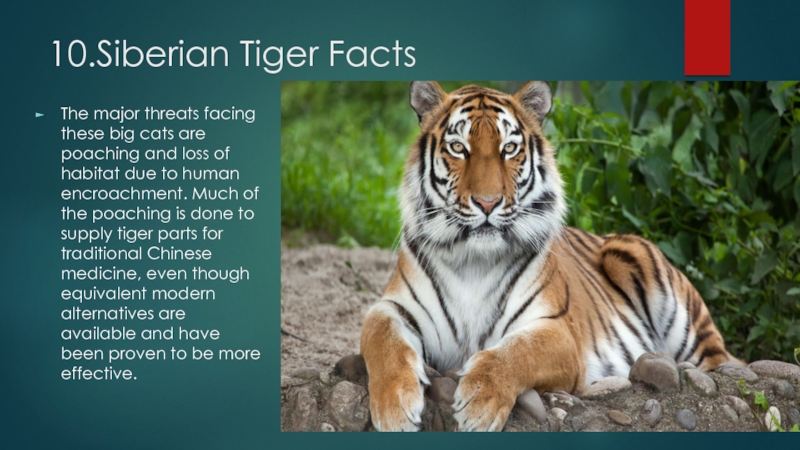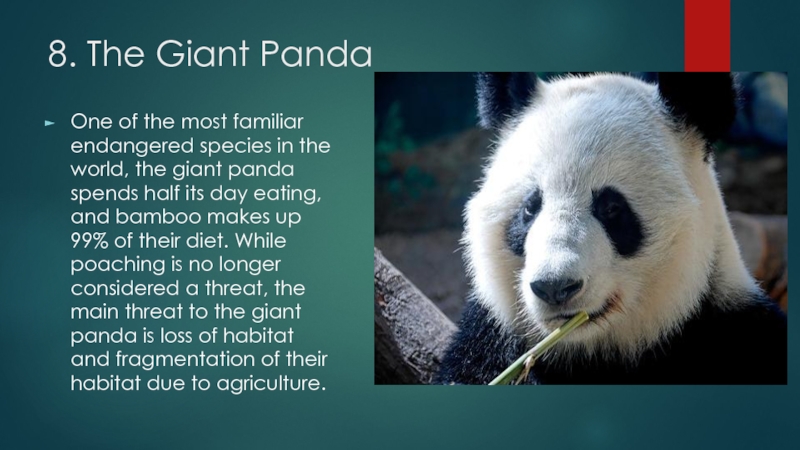- Главная
- Разное
- Образование
- Спорт
- Естествознание
- Природоведение
- Религиоведение
- Французский язык
- Черчение
- Английский язык
- Астрономия
- Алгебра
- Биология
- География
- Геометрия
- Детские презентации
- Информатика
- История
- Литература
- Математика
- Музыка
- МХК
- Немецкий язык
- ОБЖ
- Обществознание
- Окружающий мир
- Педагогика
- Русский язык
- Технология
- Физика
- Философия
- Химия
- Шаблоны, фоны, картинки для презентаций
- Экология
- Экономика
Презентация, доклад на тему Why species become extinct.
Содержание
- 1. Why species become extinct.
- 2. From the beginningLong ago, most animals and
- 3. HabitatsHabitats can be destroyed in many ways.
- 4. PollutionPollution can also kill off certain species.
- 5. People Ever since man appeared on earth
- 6. 10 of the world's most endangered speciesHere
- 7. 10.Siberian Tiger FactsThe major threats facing these
- 8. 9. The Bonobo ApeThe greatest threat facing
- 9. 8. The Giant PandaOne of the most
- 10. 7. The Mountain GorillaThese animals are threatened
- 11. 6. The Black RhinoThe greatest threat to
- 12. 5. The Hawksbill TurtleThe major threat facing
- 13. 4. The Sumatran OrangutanSumatran orangutans exist only
- 14. 3. The Fin WhaleIn the 20th century,
- 15. 2. The Asian ElephantThe main threat to
- 16. 1. The Amur LeopardOnce ranging from all
From the beginningLong ago, most animals and plants became extinct because of natural events, like earthquakes or volcano eruptions. Climatic changes, like the beginning of the Ice Age, also led to the disappearance of certain species.
Слайд 2From the beginning
Long ago, most animals and plants became extinct because
of natural events, like earthquakes or volcano eruptions. Climatic changes, like the beginning of the Ice Age, also led to the disappearance of certain species. Today, plants and animals are in danger mostly because of human beings.
Some plants and animals can survive in many areas. When they move to other places they adapt to their new environment very quickly. Others can only live in certain areas. We call such a living place a habitat. If a habitat is destroyed the species cannot find any more food or a place to live, sleep or have babies. So it dies out.
Some plants and animals can survive in many areas. When they move to other places they adapt to their new environment very quickly. Others can only live in certain areas. We call such a living place a habitat. If a habitat is destroyed the species cannot find any more food or a place to live, sleep or have babies. So it dies out.
Слайд 3Habitats
Habitats can be destroyed in many ways. More and more people
live in our world. They need more space to live in. Rainforests, grasslands and other parts of nature are cleared and people start to settle there. They take away the natural home of plants and animals.
Слайд 4Pollution
Pollution can also kill off certain species. Acid rain from factories
goes down in rivers and lakes and can poison fish there.
Слайд 5People
Ever since man appeared on earth he has killed animals
and gathered plants. They have been used for food, medicine, clothes and to make homes. Cheetahs, tigers and other wild cats have been killed for their skins. Whales have been hunted for centuries because of their oil and blubber.
Слайд 610 of the world's most endangered species
Here are 10 of the
world's most endangered species. There are many more species that are endangered or threatened with becoming endangered, but most of these are considered to be at extreme risk of extinction
Слайд 710.Siberian Tiger Facts
The major threats facing these big cats are poaching
and loss of habitat due to human encroachment. Much of the poaching is done to supply tiger parts for traditional Chinese medicine, even though equivalent modern alternatives are available and have been proven to be more effective.
Слайд 89. The Bonobo Ape
The greatest threat facing bonobos, aside from the
limited range of their habitat, is from poachers who kill the apes and sell them for bush meat
Слайд 98. The Giant Panda
One of the most familiar endangered species in
the world, the giant panda spends half its day eating, and bamboo makes up 99% of their diet. While poaching is no longer considered a threat, the main threat to the giant panda is loss of habitat and fragmentation of their habitat due to agriculture.
Слайд 107. The Mountain Gorilla
These animals are threatened by hunting and human
encroachment for agriculture and timber. While eco-tourism may help to protect these small populations, there is a risk of spreading human illnesses to the animals
Слайд 116. The Black Rhino
The greatest threat to the black rhino is
poaching. They are hunted simply for their for horns, which are used in traditional Chinese medicine, as well as for trophies and ornamental use.
Слайд 125. The Hawksbill Turtle
The major threat facing the hawksbill turtle is
the tortoiseshell trade. In the last 100 years, millions have been killed for their shells. Habitat destruction by human beach front development, excessive collection of their eggs, and poaching for meat are other major threats to their survival.
Слайд 134. The Sumatran Orangutan
Sumatran orangutans exist only on the Indonesian island
of Sumatra. Over the last 75 years, their population has been diminished by 80% due to human encroachment of their forest habitat, especially for timber and agriculture.
Слайд 143. The Fin Whale
In the 20th century, over 750,000 fin whales
were killed by commercial whalers. This second largest living animal (after the blue whale) was hunted almost to extinction until the International Whaling Commission's ban on killing them in 1976. Except for a small number of allowed kills for Norway, Japan, and Iceland, the hunting of this whale has been banned.
Слайд 152. The Asian Elephant
The main threat to Asian elephants is conflict
with humans. Since elephants are grazing animals, they need large tracts of land to feed and survive. Because of this, elephants and people cannot co-exist in regions where most of the land is used for agriculture.
Слайд 161. The Amur Leopard
Once ranging from all over Eastern Asia, the
Amur leopard, or Far Eastern Leopard, is now extinct in China and the Korean Peninsula.
Poaching and human encroachment into the habitat of the Amur leopard have led to their drastic reduction in numbers. With such a small population, genetic anomalies due to inbreeding pose a further threat to the population.
Poaching and human encroachment into the habitat of the Amur leopard have led to their drastic reduction in numbers. With such a small population, genetic anomalies due to inbreeding pose a further threat to the population.





















